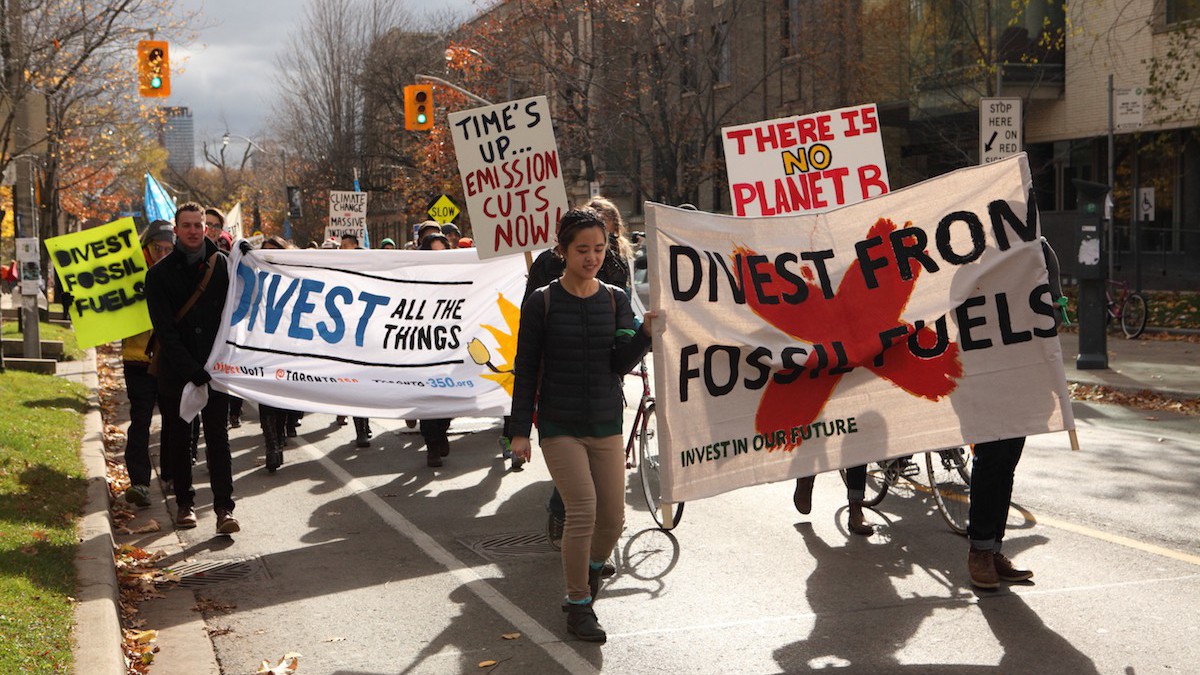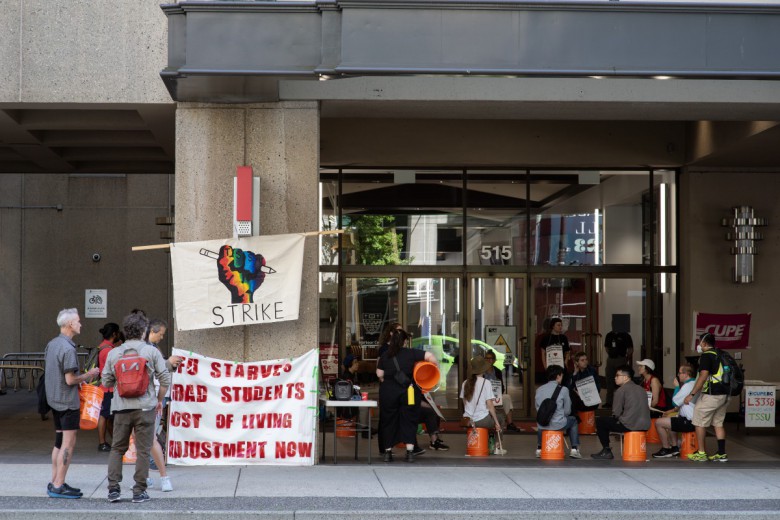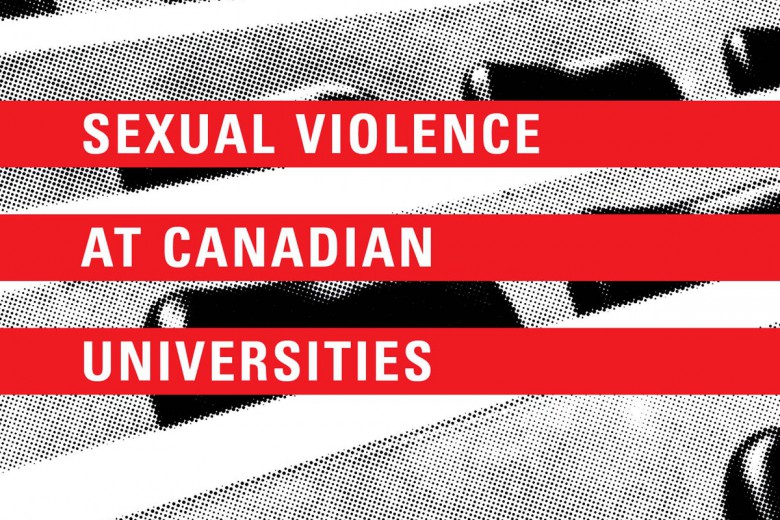“What do we want? Fossil fuel divestment! When do we want it? Yesterday!”
The chants of over 200 students echoed around Simcoe Hall and up to the second floor, where the University of Toronto’s governing council was meeting; one of the administrators peeked out at the crowd and closed the blinds. Eight days earlier, on March 30, 2016, the university president had announced that the university would not be divesting from fossil fuels. Students were livid: president Meric Gertler had gone against his own advisory committee’s recommendation to divest and had chosen to put profit over students’ futures. Organizers with UofT350, the campus group behind the divestment campaign, were especially indignant. We had followed the university’s policy on divestment, submitted a brief making our case, and built widespread support on campus (even from the president’s own advisory committee), yet it wasn’t enough.
For divestment, the question was: are you with them, the fossil fuel corporations frying the planet, or are you with us, the students fighting to protect it?
Five years later, in a letter to the U of T community, president Gertler announced that the university would finally be divesting its $4 billion endowment fund from fossil fuels. The announcement mimicked much of the divestment campaign’s messaging, citing the urgency of the climate crisis, the need for substantive and symbolic actions, the moral obligation to divest, and the impact a large institution like U of T can have when doing so. Still, when mainstream media covered the announcement, they largely failed to mention how nearly a decade of student organizing made such a decision possible.
As two former UofT350 organizers active during the campaign from 2015 to 2016, we recognize and celebrate the efforts that were made by organizers before and after us to compel the university to divest. We also believe that there is much to learn from student organizing at U of T, both when building strong divestment campaigns elsewhere and when organizing within the climate justice movement in general.
Setting the agenda, creating a moral crisis
Through the fossil fuel divestment campaign, UofT350 set a new agenda for campus climate action. The goal was to get our university to make a bold and public statement on the climate crisis by taking its money out of the industry fueling that crisis. It would be an act of institutional leadership, raising the stakes for climate action globally for years to come.
Organizers characterized investment in fossil fuels as a moral crisis. The turn to morality will be familiar to those trained in “momentum style” organizing: it is a method of “driv[ing] a wedge into the public’s moral conscience” and asking them to pick a side. For divestment, the question was: are you with them, the fossil fuel corporations frying the planet, or are you with us, the students fighting to protect it?
Organizers positioned the university as a key institutional actor with a moral responsibility to divest and situated students as critical agents capable of making that happen.
“If it’s wrong to wreck the planet, it’s wrong to profit from that wreckage” was the slogan adopted by campus fossil fuel divestment campaigns around the world, inspired by 350.org’s Do the Math documentary. This message was effective for two reasons. First, it took the abstract and global problem of climate change and linked it to financial investments, where university students and administrators can take action. Second, it framed both climate change and finances in decidedly moral and ethical terms. Investing in fossil fuel corporations, divestment campaigns argued, is fundamentally wrong. Organizers positioned the university as a key institutional actor with a moral responsibility to divest and situated students as critical agents capable of making that happen.
Organizing, mobilizing, and politicizing students
Getting students excited about and on board with divestment required multiple organizing and mobilizing tactics. UofT350 brought divestment to all corners and campuses of the university through one-on-one conversations and canvassing, class talks, movie screenings, panel discussions, leafleting, and postering. This process led to wide-ranging support: student groups voted to formally support divestment, high-profile public figures like David Suzuki and Naomi Klein signed public letters in support of the campaign, and UofT350 brought out hundreds of students to rallies and marches.
These organizing and mobilizing tactics made the climate crisis, and the university’s role in it, a topic of conversation on campus. Students and alumni started to understand how they were complicit in environmental devastation, with the former’s tuition and the latter’s annual endowment fund contributions invested in fossil fuel companies. This politicization of the climate crisis helped make the divestment campaign a popular, high-stakes, and urgent priority for all involved.
So, while organizers shared a common goal of achieving fossil fuel divestment at U of T, there were differences in how they thought we should get there.
As the movement gained strength and support, ideological disagreements over tactics, strategy, solidarity, and coalition-building increasingly plagued the group. These disagreements reflect some of the limitations of “momentum-style” organizing. The lack of a collective conceptualization of “climate justice” was at the epicentre of many of these disagreements. For example, there were frequent disagreements over how and to what extent to build solidarity with Indigenous communities and ally ourselves with the pro-Palestine boycott, divestment and sanctions movement on campus. Some organizers argued at meetings that certain types of solidarity work and direct action would alienate the public and hurt our reputation. So, while organizers shared a common goal of achieving fossil fuel divestment at U of T, there were differences in how they thought we should get there.
Students and supporters rally to condemn U of T president Meric Gertler’s rejection of his ad hoc committee’s recommendation for targeted divestment in 2016.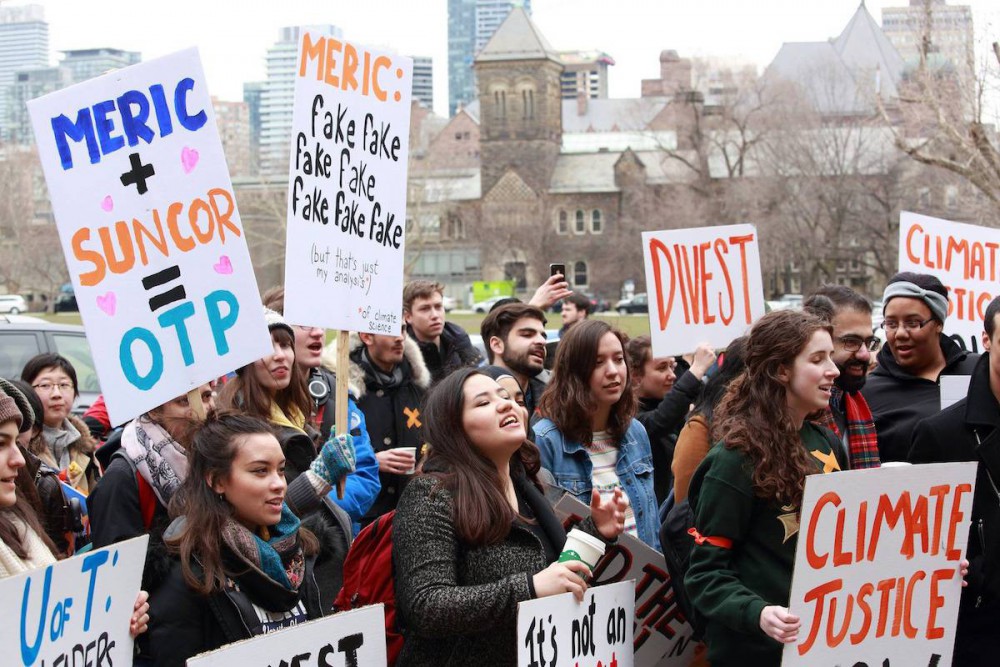
Playing the inside/outside game
From its inception, the divestment campaign employed what we referred to as “inside game” and “outside game” strategies. The outside game largely referred to the organizing and mobilizing tactics described in the previous section. The inside game referred to actions carried out within the institution itself, in direct contact with university decision makers.
There are two ways to play the inside game: following the rules and expecting to be rewarded, and knowing the rules and leveraging them to your advantage. In the early days of the divestment campaign, organizers largely did the former. We followed the institutional process laid out for us and made very persuasive arguments in an effort to convince (rather than compel) the university to divest. Embedded in this approach was an underlying assumption that UofT350 as a whole needed to maintain positive relationships with the university. This created rifts in the group when those playing the outside game pushed too hard in a way that some thought might jeopardize our relationship with the university.
It’s worth noting that university administrators create, compare, and discuss their own “inside game” divestment strategies. For instance, at a Canadian Association of University Business Officers (CAUBO) workshop in 2016, participants advised university administrators to “proactively establish a process for handling divestment requests” as an effective way to manage a movement.
The university benefited from the way we “civilly” and “rationally” played the inside game, and the university’s rejection of divestment in 2016 reveals the risks and consequences of such an approach.
This does not mean that student organizers should not engage in inside approaches, but it does require going in with open eyes, including being aware that some people (white, straight, wealthy men) will be allowed to navigate elite institutions more easily than others.
While UofT350 struggled to put the inside game and the outside game into effective dialogue, there were glimpses of the two approaches synchronizing around the time of president Gertler’s rejection. For instance, during the emergency rally for divestment post-rejection, the few organizers who went inside to attend the governing council meeting were texting the organizers outside who kept the crowd of 200 supporters up to date on what was happening at the meeting. At one point, the president referred to divestment at U of T as “small potatoes,” which led to chants from the crowd outside and hashtags and memes following the rally. By sharing information from inside the meeting, organizers sent a message to the university that we were calling into question not only the president’s decision but also the institutional processes that we had followed until then.
President Gertler noted in 2016, “I’ve been so impressed by UofT350, by the way that they have engaged these discussions in a civil and calm and rational way and I hope we can continue that.” The university benefited from the way we “civilly” and “rationally” played the inside game, and the university’s rejection of divestment in 2016 reveals the risks and consequences of such an approach. We implore future organizers to “play hard and smart,” intentionally and cohesively employing inside and outside game approaches, toward campaign objectives and broader systemic changes.
Maintaining the terms of debate and bringing it home
Divestment organizers often struggled to find the right balance of tactics, but they were successful in holding a strong moral line – to not only set but also maintain the terms of debate. Doing so was not easy, as the U of T administration was also determined to control the narrative. In the CAUBO workshop noted earlier, vice-president of communications David Estok revealed how U of T’s approach was to “shift the debate from divest or not to a broader discussion about how the university can contribute to the fight against climate change.” Students pushed back, refusing to allow the debate to drift.
Increasingly, students turned to exposing university actions and messaging as hypocrisy, greenwashing, and doublespeak. The emergency rally was one such example: Students dubbed the occasion a “Beyond Bullshit” rally, a play on the title of the president’s “Beyond Divestment” report. Years later, the infamous report would serve as the inspiration for a new student-faculty-staff coalition, “Divestment and Beyond,” an enduring reminder of the university’s efforts to change the terms of debate and the university community’s dogged refusal.
What’s next?
Nearly a decade of student organizing brought about a major victory in U of T’s divestment announcement, but there is still work to be done. LeapUofT and Divestment and Beyond continue to monitor and advocate in favour of divestment of the federated colleges at U of T as well as in the newly formed university pension plan. Some divestment organizers have transitioned to working on campaigns to push banks to divest from fossil fuels. Others bring the skills and analysis they developed working on divestment to other activist and non-activist projects.
Developing ideology is an iterative process – it requires both thoughtful discussion and learnings garnered from real-world experience in social struggle.
Divestment was effective because it was a clear, focused, and winnable campaign that pulled on people’s sense of right and wrong. Building on the potential created by a moral crisis requires disciplined organizing, including the strategic use of both the inside and outside game. Still, sustaining a broad-reaching movement that can withstand campaign setbacks, internal disagreements, and challenging forks in the road requires a coherent and shared political ideology. Developing ideology is an iterative process – it requires both thoughtful discussion and learnings garnered from real-world experience in social struggle. For those still engaged in the struggle, we will see you in the streets!
Activists gather in front of the U of T during the second divestment march in October 2015.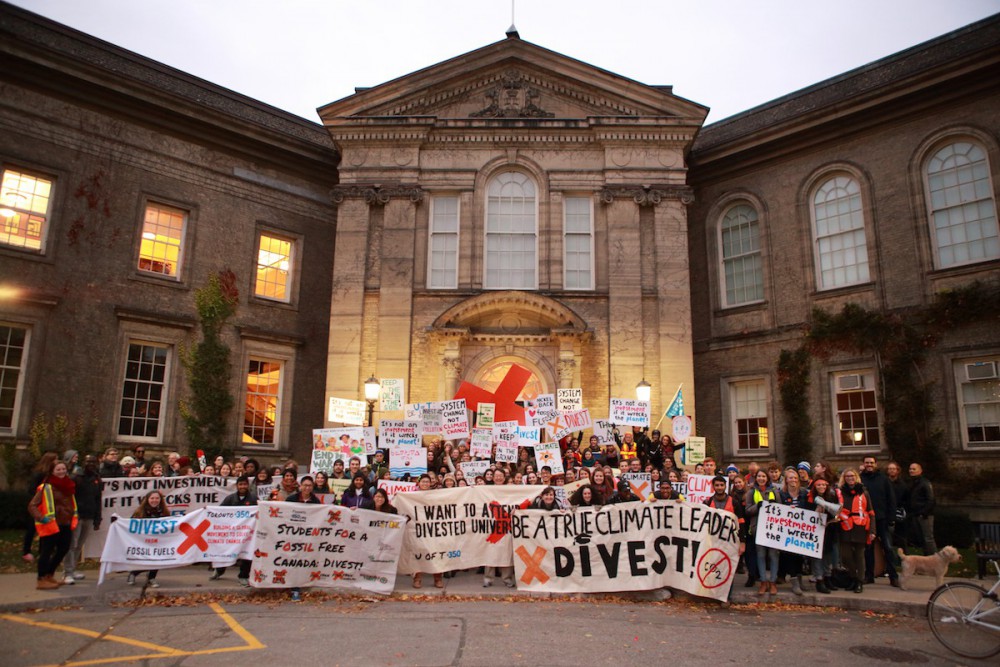
Divestment: a timeline
By Amanda Harvey-Sánchez; adapted from the U of T Fossil Fuel Divestment Timeline.
2012–2015: Set the agenda, understand the system, and take the bull by its horns
The University of Toronto fossil fuel divestment campaign began in June 2012 when a group of U of T students and community members founded the grassroots group Toronto350.org and later, UofT350, the campus branch of the group. U of T already had a “Policy on Social and Political Issues With Respect to University Divestment,” a set of procedures that prescribed how and when activists could raise issues about the university’s harmful investments, and how and when the university would respond. UofT350 had to learn to navigate the institutional and bureaucratic channels set out in the policy. This included writing a “brief” to make the case for divestment, communicating with the president’s ad hoc committee on divestment, and following the proceedings of the governing council. Alongside this, UofT350 worked with campus groups, student unions, and alumni to build broad support for fossil fuel divestment through letter writing, art builds, panel discussions, movie screenings, marches, and rallies.
December 2015–March 2016: When you think you’ve won, fight on!
On December 15, 2015, the president’s ad hoc committee on fossil fuel divestment published the “Report of the President’s Advisory Committee on Divestment from Fossil Fuels,” recommending “targeted” fossil fuel divestment. The announcement garnered widespread media attention and came to be known as the “Toronto Principle.” This was a huge win for the campaign!
Following a brief meeting with the president in February, UofT350 published a “Community Response.” The response pushed to expand and refine the recommendations in the ad hoc committee’s report and proposed new criteria to screen investments that account for Indigenous Rights. In the lead up to “decision day,” March 30, 2016, UofT350 staged banner drops across campus with messages such as “Divestment is Coming.”
March 2016: Naïveté and betrayal
On March 30, 2016, president Gertler rejected his own ad hoc committee’s recommendation for targeted divestment in a report entitled “Beyond Divestment: Taking Decisive Action on Climate Change.” While UofT350 knew that this outcome was possible, it was still shocking. UofT350 staged public demonstrations throughout April, including an emergency rally for divestment outside a governing council meeting while a UofT350 member addressed the president directly inside. Students and supporters were indignant, but they struggled to channel that anger into effective organizing. Struggling with burnout, internal ideological disagreements, and the graduation of many long-time organizers, UofT350 fizzled out as a group.
Fall 2016–2021: New groups emerge and pick up the mantle
That fall, a new cohort of students founded Leap UofT as the U of T campus branch of the international non-profit The Leap. Leap UofT set out to relaunch the U of T fossil fuel divestment campaign with a more explicit focus on the connections between climate justice and economic, social, and environmental justice. Leap UofT broadened its focus to include parallel campaigns targeting the federated colleges at U of T. In the fall of 2019, a group of students, faculty, and staff founded the Divestment and Beyond coalition.
October 2021: Playing the long game – U of T divests
On October 27, 2021, in a letter to the U of T community, president Gertler announced that the University of Toronto was committing to divest from investments in fossil fuel companies in its endowment fund beginning immediately. It was a surprising but hard-won victory for the generations of students, faculty, and staff who had poured their hearts into striving for divestment.


